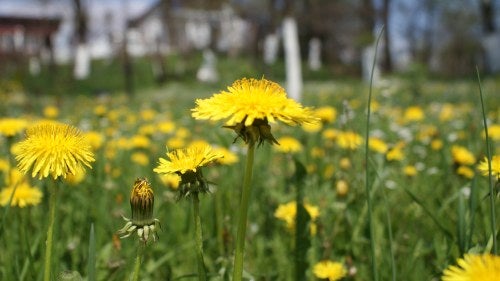Embracing Dandelions as Food and Medicine

Through their connection to traditional food practices, dandelions challenge colonized notions of food security and provide students with the opportunity to reconnect with Indigenous food systems.
In October of 2022, the Chicago Council on Global Affairs launched a blog series titled, “Stewardship, Sovereignty, and Solutions” that features the voices of guest authors from Indigenous organizations and communities. Recognizing that Indigenous communities around the world disproportionately experience the pressures of climate change, global conflicts, and the pandemic, while simultaneously stewarding 80 percent of the world’s biodiversity, the blog series aims to highlight Indigenous and traditional agricultural practices in the United States and globally. In bringing attention to Indigenous agriculture and foodways, we aim to promote a truly inclusive global food system that recognizes and actively counteracts the oppression of Indigenous peoples.
One of the first assignments I give my Indigenous Food Sovereignty students at United Tribes Technical College is to record themselves eating five dandelion leaves. The assignment is as simple as it sounds: students can eat the leaves raw or cooked, and the leaves can be prepared (or not) in whatever method they prefer – as long as they 1) film the event, and 2) eat all five leaves. Dandelions can be quite bitter, which is a difficult flavor for many people to swallow. In American society, we have been conditioned to believe that our food should be sweet, salty, sour, or spicy. We have largely forgotten that bitter flavors—in the form of greens, teas, and sauces—were once a vitally important part of everyone’s diets. Over decades of exposure to sugary sweets and salty snacks, many people now associate bitter flavor profiles as being unpleasant or even toxic. Consequently, dandelions have become less desirable for the average American palate and instead are viewed as a weed, an invader, and a nuisance, with Americans spending thousands of dollars each year on eradicating dandelions from manicured lawns. This was not always the case: dandelions were held in high regard for their medicinal and nutritious benefits, and are still considered a specialty commodity crop of high value among farmers and foragers.1
Dandelions are both food and medicine. Dandelions have been traditionally used by Indigenous communities in meals and to help treat common ailments and improve physical health in ways that have long been ignored, with benefits that extend beyond the corporeal world. Through their connection to traditional food practices, dandelions challenge colonized notions of food security, renewing my students’ relationships to traditional food systems and advancing Indigenous food sovereignty.
Why Dandelions?
Indigenous peoples all over the world have long recognized that Taraxacum officinale and its close relatives are not only a delicious green vegetable that lends itself to boiling, frying, blanching, fermenting, and pickling, but are also an amazing medicine, with compounds that lower blood sugar, destroy certain types of cancer cells, reduce inflammation, and improve liver function.2 They are edible from root to flower, and provide substantial vitamins, minerals, fiber, and antioxidants that have nutritional and medicinal benefits. Dandelions can be immensely helpful to improving one’s health, which has been recognized by Indigenous communities for millennia. Indigenous peoples in China and India, in particular, have been growing dandelions as food and medicine as far back as the tenth century.
As an instructor, I enjoy providing my students with information on all kinds of relevant topics, but my real objective is to change their relationship with the natural world – more specifically, their own homelands. I want to be a facilitator on their journey to connect and reconnect with the earth, water, plant life, and wildlife that has always been part of their birthright. Instead of looking at dandelions as weeds, I want these college freshmen to see this golden blossom as both food and medicine. This perspective is, after all, deeply rooted in their psyches already, as their ancestors have long and storied relationships with dandelions and related plants for millennia, dating back to a time prior to colonization.
Identifying Indigenous Food Sovereignty
Until recently, sovereignty has been largely absent from conversations on food. Instead, the focus was on “food security” which aims to end hunger and ensure that people can eat enough calories on a daily basis. The food security movement is exemplified by various grassroots backpack food programs that were implemented across the country in the early 2000s. Backpack programs sent bags of food home with children on holidays and weekends. These bags were often filled with non-perishable items such as such as canned soup, juice boxes, cereal bars, and deli meat and cheese-type snack boxes. These items are fairly filling, but tend to be high in sodium, sugar, preservatives, and simple carbohydrates; backpack food programs are helpful in relieving hunger, but they can also be unhealthy. When these types of foods are consumed in Indigenous communities and other communities of color, they further contribute to extremely high rates of diabetes and obesity. Indigenous people alone experience diabetes at twice the rate of white people,3 and are 50 percent more likely to be obese.4 They also have life expectancies up to 20 years lower than non-Indigenous people, as they are more likely to suffer from poorer health and malnutrition due to higher rates of extreme poverty and their disproportionate vulnerability to environmental degradation and ecosystem contamination.5 This is only exacerbated when Indigenous people eat colonized foods, relegating Indigenous communities to some abysmal health statistics and making food security initiatives like backpack food programs a double-edged sword.
In contrast to backpack food programs, the concept of food sovereignty focuses on a community’s control over their entire food system, from production and distribution to seed sourcing and preparation. Providing sufficient calories is certainly important, but the food sovereignty movement goes beyond, with the underlying premise that everyone should have access to foods that support just, healthy, and sustainable communities.
Indigenous food sovereignty is an important extension of the food sovereignty movement. The repeated and continued disruption of Indigenous food systems has been intentional and devastating, leading to the elimination of Indigenous people’s sacred food sources, destabilizing Indigenous communities, and undermining Indigenous self-determination. The Indigenous food sovereignty movement seeks to change colonial policies and practices that have cut communities off from their traditional foods and contributed to devastating health statistics, specifically Indigenous people’s disposition to overall poorer health compared to non-Indigenous people.6
How Do Dandelions Contribute to Indigenous Food Sovereignty?
Dandelions are extremely common in North America due to their ability to tolerate a wide range of weather conditions,7 making them a relatively recognizable non-agricultural plant in the United States. Although this may result in frustrated efforts to eliminate them from manicured lawns, they offer much more value than what meets the eye. Dandelions are a starting point, a place from which my students might reconnect to plants, and therefore to their own traditional foods and medicines.
Through acknowledging the benefits dandelions provide, my students are connecting with their traditional values and rejecting colonized foods that lead to Indigenous people’s disproportionate health burdens. This process of unlearning colonial narratives and rediscovering Indigenous ways of knowing is central to Indigenous food sovereignty, making dandelions a part of the Indigenous food sovereignty itself.
None of this happens overnight. My students can be slow to adapt to Indigenous understandings of dandelions. When completing the dandelion assignment, they often choose to hide the dandelions’ flavor by wrapping it in bacon or smothering it in ranch; however, my students are still taking an important step towards realizing that dandelions are food and medicine. Even if they are covering dandelions in bacon bits and ranch dressing, my students are still reconnecting to an important part of their traditional food system.
By the end of the semester, I can see a significant change in my students. Dandelions as food and medicine becomes a well-known concept for them, especially after trying everything from stinging nettles, insects, and fermented berries to organ meats and mushrooms. After spending time building relationships, the dandelions begin to communicate with my students. They represent our need to rethink the way we look at the world, explore the relationships we have, and nurture our relationship with the Earth as we continue our journey towards Indigenous food sovereignty.
- 1
"Signs of the Seasons: A New England Phenology Program." University of Maine. University of Maine. Accessed February 15, 2023.
- 2
"Dandelion." Mount Sinai Health System. Accessed February 15, 2023.
- 3
"Native Americans with Diabetes: Better Diabetes Care Can Decrease Kidney Failure." Centers for Disease Control and Prevention. Centers for Disease Control and Prevention, November 15, 2018.
- 4
“Obesity and American Indians/Alaska Natives." Office of Minority Health. US Department of Health and Human Services, March 26, 2020.
- 5
“Health for Indigenous Peoples." Department of Economic and Social Affairs: Indigenous Peoples. United Nations. Accessed February 15, 2023.
- 6
"The Health of Indigenous Peoples." Inter-Agency Support Group on Indigenous Peoples' Issues. United Nations, June 2014.
- 7
"Signs of the Seasons: A New England Phenology Program." University of Maine. University of Maine. Accessed February 15, 2023.


Related Content
- Embracing Dandelions as Food and Medicine
- Going Beyond Regenerative Agriculture on Tribal Lands
- Expanding "638" to Enhance Native American Food Sovereignty
- Flavors and Culture: Food Systems Through Indigenous Women's Eyes
- A Thanksgiving Legacy: Fighting for Indigenous Food Sovereignty
- Native Food Sovereignty: Strengthening Connection to Culture
- Reconnecting to Indigenous Food Sovereignty Values and Practices
- Embracing Interconnectedness: How Indigenous Foodways Can Save Us